Table of contents:
- Apple iPhone 15 Pro and 15 Pro Max;
- Comparison of Pricing and Storage Options;
- Titanium and USB-C in iPhone 15 Pro Design;
- The Action Button: A Farewell to the Mute Switch;
- Cost Comparison for Back Glass Replacement;
- 5x Telephoto Zoom in iPhone 15 Pro Max;
- iPhone 15 Pro Max Cameras with Pixel 7 Pro and Galaxy S23 Ultra;
- Effortless Portraits and Enhanced Lens Coating;
- iPhone 15 Pro: A Gaming Powerhouse;
- The iPhone 15 Pro: iOS 17’s Ultimate Home;
- iPhone 15 Pro vs. Pro Max, Pixel 7 Pro, S23 Ultra;
- The iPhone 15 and Its A16 Bionic Chip;
- iPhone 15 vs. iPhone 14;
- Final thoughts.
The distinguishing features of the iPhone 15 Pro and 15 Pro Max are their enhancements, which include a lighter titanium body, a USB-C port for swift charging and data transfers, a processor with console game capabilities, and, exclusive to the Pro Max model, a novel 5x telephoto zoom camera.
| Pros | Cons |
|---|---|
| Lighter and more comfortable to hold | Action button can only trigger one action |
| 5x optical zoom in 15 Pro Max | Baseline 15 Pro Max is $100 more |
| A17 Pro for console video games | Limited color options (only blue) |
| Adjustable focus in Portrait photos |
Having reviewed and tested iPhones extensively over the years, the Apple iPhone 15 Pro Max stands out as a remarkable addition. (The iPhone 12 Mini closely follows in terms of appeal.) These smartphones, alongside the iPhone 15 and 15 Plus, as well as the latest Apple Watches, are now readily available in stores.
Apple has given its Pro models a substantial makeover, featuring a refreshed, lighter build, the introduction of a new shortcut button, and the inclusion of the world’s smallest processor. Remarkably, all of these improvements are achieved while preserving the timeless iPhone aesthetic as the focal point. Throughout the assessment of both phones, videos were recorded featuring gracefully swimming penguins, console gaming sessions with Resident Evil Village on the 15 Pro, experimentation with the 15 Pro Max’s new zoom lens while atop a San Francisco Ferris wheel, and an occasional attempt to connect a Lightning cable to the new USB-C port. Some habits, it seems, persist regardless of the changes.
The defining features of the iPhone 15 Pro and 15 Pro Max are their refinements, making this phone duo one of the most captivating releases from Apple in recent years.
However, these enhancements come with an associated cost. While the 15 Pro is priced at $999 (£999, AU$1,849), the 15 Pro Max requires a $100 higher investment compared to the previous year. Apple has eliminated the least expensive 128GB storage option, making the $1,199 model with 256GB of storage the new starting point. This places its pricing directly in line with Samsung’s Galaxy S23 Ultra.
For additional insights into Apple’s other phone releases, you can refer to CNET Senior Editor Lisa Eadicicco’s review of the iPhone 15 and 15 Plus.
Comparison of Pricing and Storage Options
| Phone | Storage | US Price | UK Price | Australia Price |
|---|---|---|---|---|
| iPhone 15 Pro | 128GB | $999 | £999 | AU$1,849 |
| iPhone 15 Pro | 256GB | $1,099 | £1,099 | AU$2,049 |
| iPhone 15 Pro Max | 256GB | $1,199 | £1,199 | AU$2,199 |
| iPhone 15 Pro | 512GB | $1,299 | £1,299 | AU$2,399 |
| iPhone 15 Pro Max | 512GB | $1,399 | £1,399 | AU$2,549 |
| iPhone 15 Pro | 1TB | $1,499 | £1,499 | AU$2,749 |
| iPhone 15 Pro Max | 1TB | $1,599 | £1,599 | AU$2,899 |
Titanium and USB-C in iPhone 15 Pro Design
The new titanium body presents an attractive, lightweight, and easily grippable design, thanks to its subtly rounded edges. It imparts a less cumbersome feel compared to the straight-edged 12, 13, and 14 series. In essence, it’s as if Apple has amalgamated the curved edges of the X, XS, and 11 series with the more angular sides of recent models, striking a balanced middle ground with the 15 Pro and 15 Pro Max. Nevertheless, for most individuals, placing a case on the phone will likely obscure these alterations altogether.
Two significant alterations are evident in the device’s body.
- Firstly, the replacement of the Lightning port, featured in prior models, with a USB-C port has garnered substantial attention. However, in practice, this change isn’t groundbreaking. Now, instead of utilizing a Lightning cable, a USB-C cable (provided with the phone) is employed for charging. This transition offers the convenience of using a universal charging cable;
- Secondly, there is a noteworthy difference in the buttons. The volume buttons exhibit a slightly more resilient quality compared to those on previous stainless steel Pro models. It’s akin to wearing sneakers with foam soles, providing that added bounce in your step, as opposed to the airbag cushioning prevalent in shoes like the Nike Air Max from the ’80s and ’90s. Both options are comfortable, but the newer foam-based design offers enhanced comfort.
The Action Button: A Farewell to the Mute Switch
The traditional mute (or silence) switch has made way for the innovative action button. By default, it functions as a means to silence your iPhone, but its versatility allows customization to perform various actions, such as activating the flashlight, recording voice memos, or opening the camera, among other functions. Notably, the camera function was a personal favorite, and once the camera app is active, the action button conveniently serves as a physical shutter button for capturing photos. However, the real appeal lies in its potential to trigger shortcuts, greatly expanding its utility.
The action button responds to two primary types of input: a tap or a press. Currently, it has the limitation of executing only one feature at a time, which may seem restrictive. It is hoped that Apple will enhance its functionality by enabling users to program multiple presses and taps to activate various preset actions. For example, two consecutive presses could initiate a shortcut, while a single press could silence the phone. Presently, the sole method for adjusting the button’s function is through the Settings app, where users can navigate to the action button settings. Additionally, the option to include a Control Center button for quicker access to this action button menu would be a welcome addition.
Similar to the redesign seen in the 14 and 14 Plus models from the previous year, the 15 Pros feature an entirely overhauled interior that simplifies the repair process. In the event of damage to the back glass, the replacement procedure should be quicker and more cost-effective. Below, we provide a comparison of the expenses associated with replacing the back glass on the latest phone compared to older Pro iPhone models.
Cost Comparison for Back Glass Replacement
| Phone | iPhone 15 Pro | iPhone 15 Pro Max | iPhone 14 Pro | iPhone 14 Pro Max |
|---|---|---|---|---|
| Cost (Back Glass Replacement) | $169 | $199 | $499 | $549 |
5x Telephoto Zoom in iPhone 15 Pro Max
Now, let’s delve into the details. It’s important to note that the zoom lens on the smaller Pro differs from the one found on the larger Pro Max. The iPhone 15 Pro features the familiar and reliable 3x telephoto camera, akin to previous models. On the other hand, the iPhone 15 Pro Max boasts a novel 5x telephoto camera, crafted using multiple prisms and ingenious engineering.
In contrast, several Android phones employ periscope-style telephoto lenses, utilizing a single prism to redirect light to the sensor, such as the 10x zoom on the Samsung Galaxy S23 Ultra. Apple’s design offers a distinct advantage in terms of space efficiency, allowing the lens to occupy significantly less space and enabling the image sensor to align parallel with the lens. This innovative approach eliminates the limitations associated with telephoto image sensors constrained by the phone’s thickness.
Both Pro phones feature a larger 48-megapixel sensor for the primary camera, contributing to enhanced low-light performance. While capturing photos with the iPhone 15 Pro Max and 14 Pro Max in dim lighting conditions, it became apparent that the newer phone relied less on night mode. Additionally, the photonic engine, referred to as Apple’s advanced photo processing technology, appears to have a positive impact on managing highlights.
iPhone 15 Pro Max Cameras with Pixel 7 Pro and Galaxy S23 Ultra
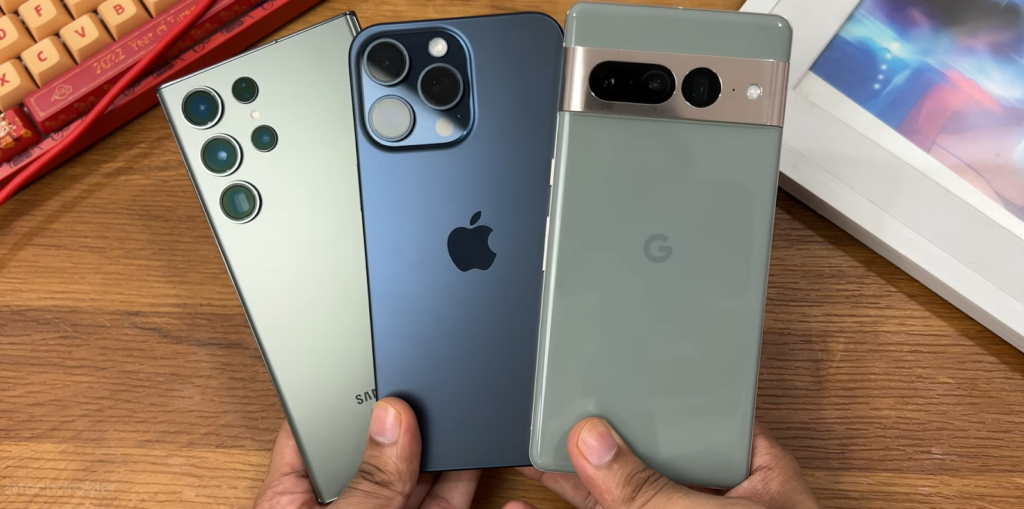
| Smartphone | Rear Camera Features | Front-facing Camera Features | Video Capture |
|---|---|---|---|
| Apple iPhone 15 | 48MP wide, 12MP ultrawide | 12MP | 4K |
| Apple iPhone 15 Plus | 48MP wide, 12MP ultrawide | 12MP | 4K |
| Apple iPhone 15 Pro | 48MP wide, 12MP ultrawide, 12MP telephoto | 12MP | 4K |
| Apple iPhone 15 Pro Max | 48MP wide, 12MP ultrawide, 12MP telephoto | 12MP | 4K |
| Samsung Galaxy S23 | 50MP wide, 12MP ultrawide, 10MP telephoto | 12MP | 8K |
| Samsung Galaxy S23 Plus | 50MP wide, 12MP ultrawide, 10MP telephoto | 12MP | 8K |
| Samsung Galaxy S23 Ultra | 200MP wide, 12MP ultrawide, 10MP telephoto | 12MP | 8K |
| OnePlus 11 | 50MP wide, 48MP ultrawide, 32MP telephoto, 10MP telephoto | 16MP | 8K |
| Google Pixel 7 Pro | 50MP main, 12MP ultrawide, 48MP telephoto | 10.8MP | 4K at 60fps |
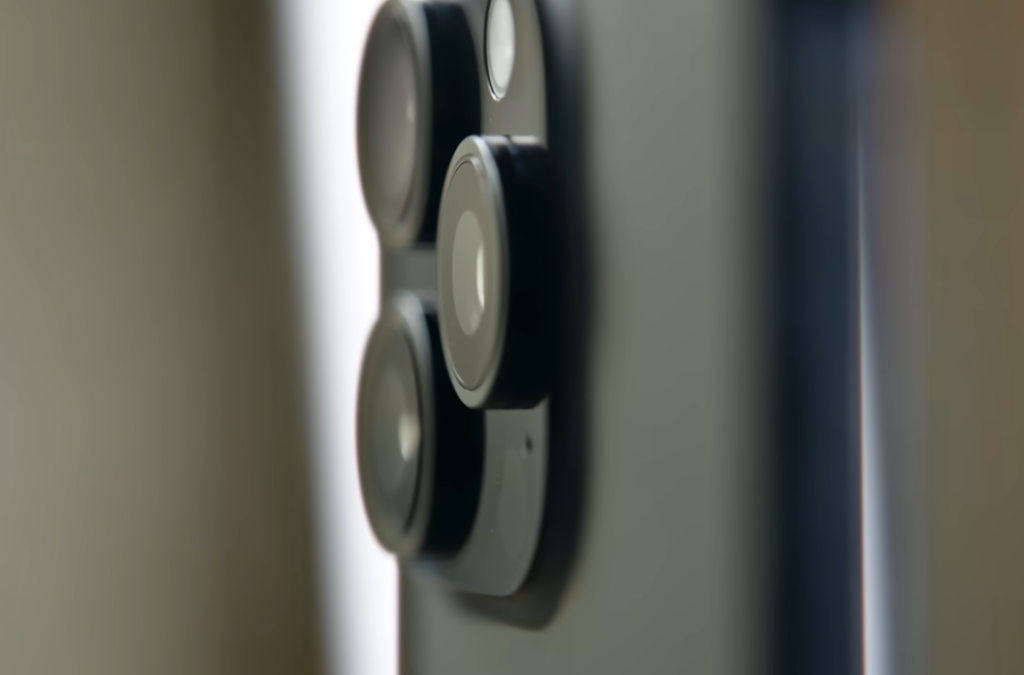
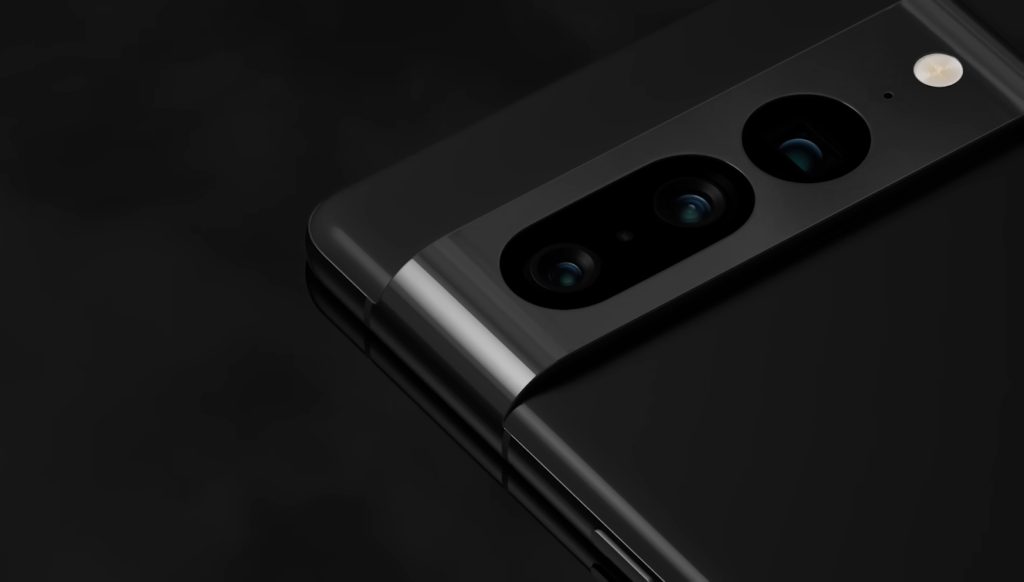
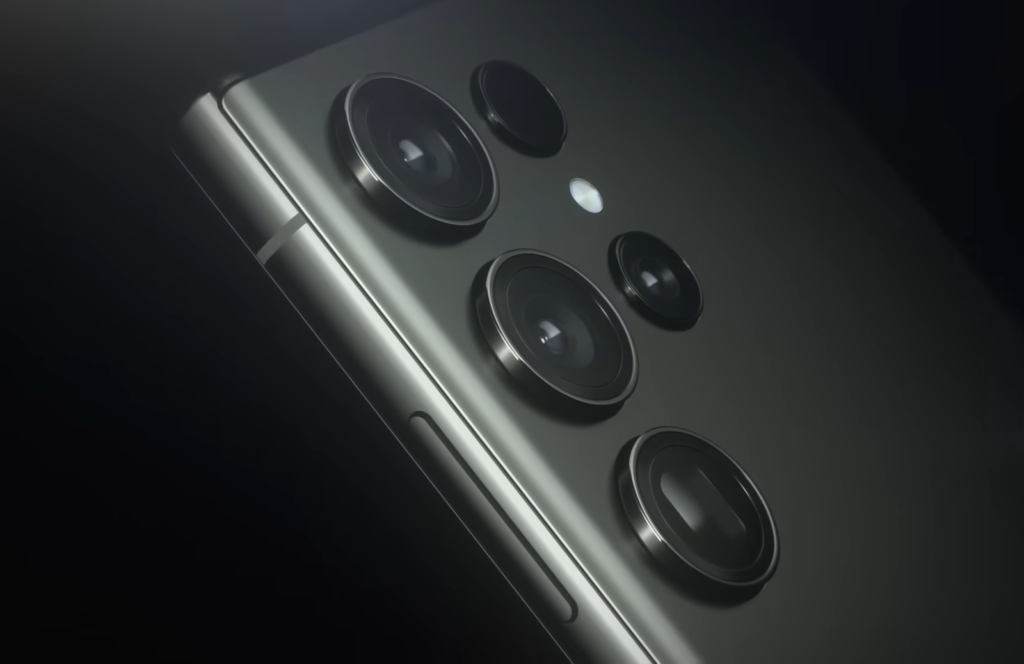
Camera enthusiasts will find plenty to appreciate in the iPhone 15 Pro Max, which now boasts a 5x zoom camera capable of delivering remarkable results across a spectrum of lighting conditions. However, the competition remains fierce, with both Samsung and Pixel continuing to astound with their camera prowess, each excelling in its own unique way. While the iPhone shines in certain aspects, Samsung and Pixel devices hold their ground, showcasing their distinct strengths.
When it comes to making the right choice, the iPhone 15 Pro Max stands out for its robust software support and top-notch performance, making it an ideal pick for those seeking longevity and high-end power. Samsung’s Galaxy S23 Ultra impresses with its stylish design and rapid charging capabilities, while the Google Pixel 7 Pro serves as a compelling budget-conscious option, offering strong software features and impressive camera capabilities.
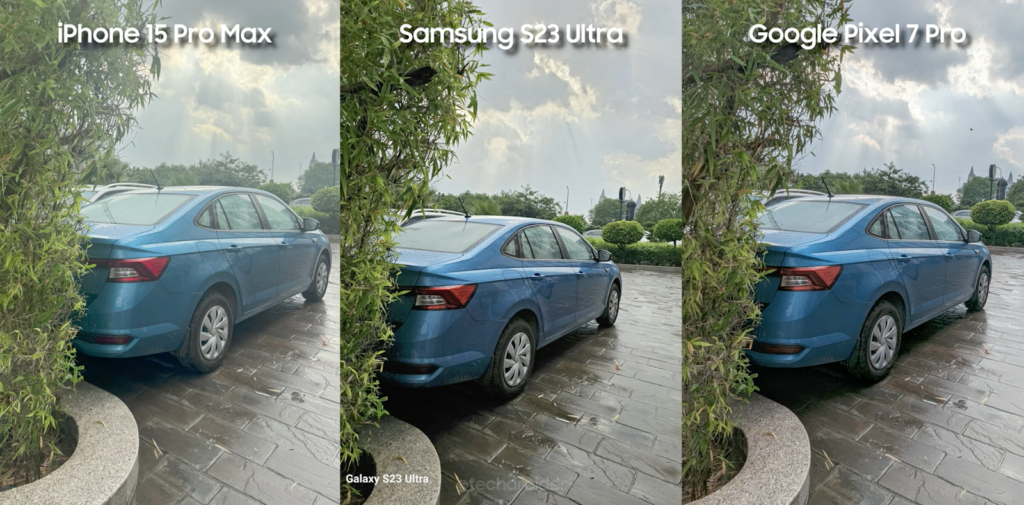
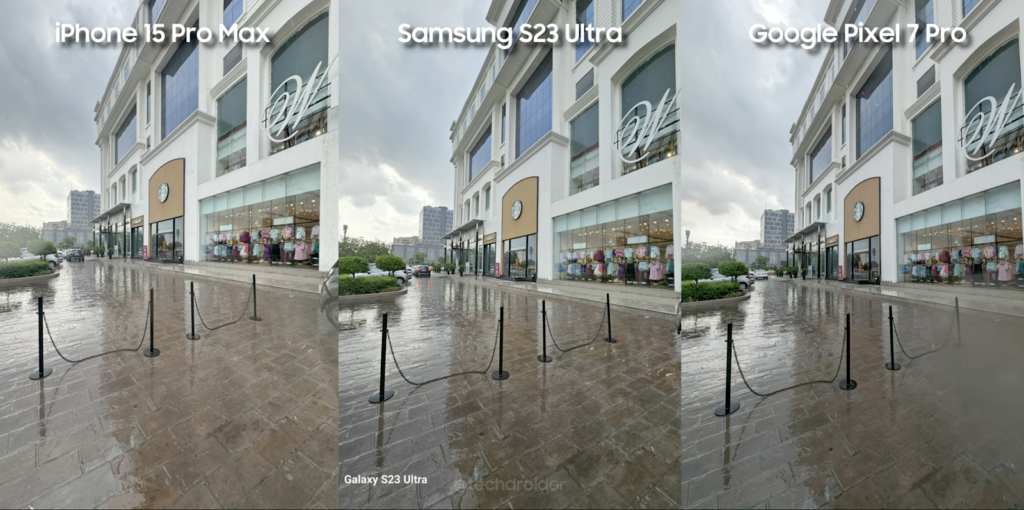
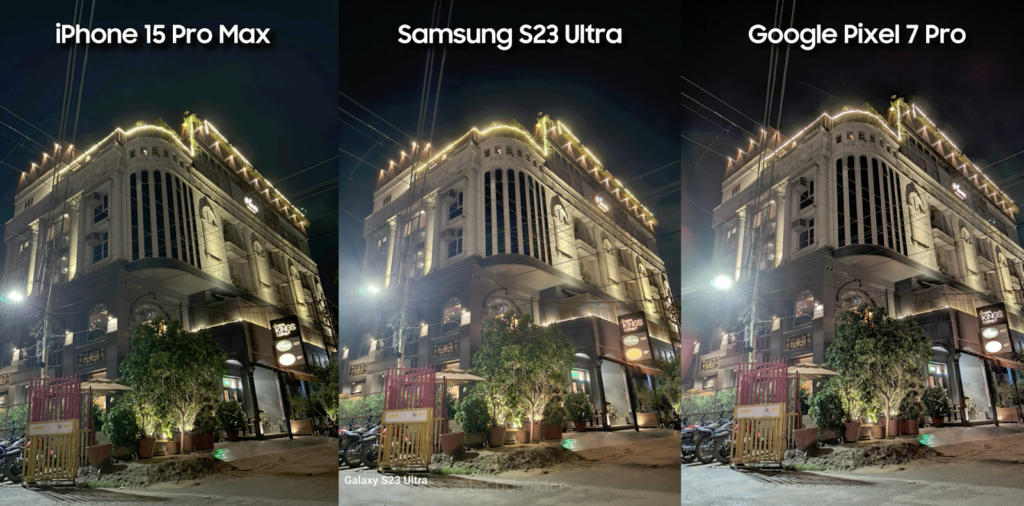
Effortless Portraits and Enhanced Lens Coating
In the realm of photography, the iPhone 15 Pro simplifies the art of capturing portraits. Its portrait mode allows the conversion of standard photos into captivating portrait mode images, particularly suited for specific subjects like humans, dogs, and cats.
Furthermore, the introduction of a new lens coating in the 15 Pro and 15 Pro Max models proves beneficial in diminishing reflections stemming from light sources. In general, reflections or lens flares, if present, are minimal and often manifest as singular points of light.
However, in night mode, an intriguing phenomenon emerges when utilizing the 5x telephoto camera on the 15 Pro Max in environments illuminated by string lights and interior lamps. This occurrence prompts curiosity about whether it is associated with the prisms employed within the lens. It is worth noting that, out of the numerous photographs taken, only three exhibited these streaks.
Shifting to the realm of video recordings, the results are impressive. The capability to record in a log format is particularly noteworthy, as it produces footage characterized by a flat and desaturated color profile. This log format grants more flexibility in harmonizing the color of iPhone videos with footage from other cameras, as opposed to embedding color information within the video file. This feature positions Apple log videos as a valuable asset for diverse applications, including cinematic productions employing cameras from various brands or crafting engaging social media content, akin to the one generated for this review.
iPhone 15 Pro: A Gaming Powerhouse
At the core of the 15 Pro and 15 Pro Max lies the new A17 Pro chip, orchestrating the entire experience. Its true prowess emerges when engaged in the world of video games, and not limited to casual games like Candy Crush.
The 15 Pro and 15 Pro Max offer robust support for full-scale console games, such as Resident Evil Village, a title evaluated, at least in its initial stages. The visual performance of Resident Evil Village on the 15 Pro Max’s display is nothing short of remarkable, particularly with regards to its lighting and shading. From the perspective of dedicated but casual gamers, the experience is highly impressive. The fact that such immersive games can now be enjoyed on an iPhone speaks volumes.
While the time with the new iPhones has been relatively short, comprehensive battery drain and charging tests are yet to be conducted. However, an initial assessment of the battery performance reveals that the 15 Pro Max’s battery comfortably sustained a full day of usage, typically concluding the day with a residual charge of 20% to 25%. Even on the most demanding day, which involved extensive photography, video recording, and maximum screen brightness, the 15 Pro Max managed to start the day with a full battery and had 7% remaining by day’s end.
In addition, a wired charging test with both the 15 Pro and Pro Max was conducted, employing the provided USB-C cable and a Twelve South 20-watt wall charger. Within 30 minutes, the 15 Pro’s battery surged from 4% to 66%, while the 15 Pro Max’s charge went from 7% to 56%. Both phones support wired charging at speeds of up to 27 watts, with further exploration intended, updating the review with the results.
The iPhone 15 Pro and 15 Pro Max also embrace 15-watt wireless charging via MagSafe or Qi2. Testing, conducted using a Belkin BoostCharge Pro stand, revealed similar outcomes within a 30-minute window. Specifically, the 15 Pro advanced from 30% to 52%, while the 15 Pro Max progressed from 7% to 28%. These results underscore the efficiency of wireless charging across both models.
The iPhone 15 Pro: iOS 17’s Ultimate Home
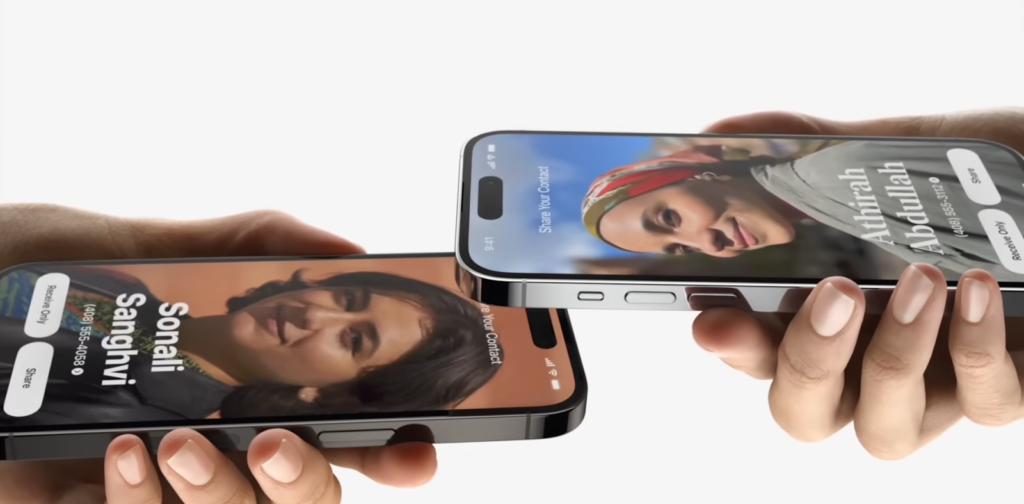
In the realm of the iPhone 15 Pro and 15 Pro Max, the A17 Pro chip serves as the intellectual powerhouse, while iOS 17 stands as their quintessential essence. The new operating system introduces an array of subtle yet impactful quality of life enhancements. StandBy mode, in particular, has garnered acclaim, offering the convenience of displaying the time in alarm clock-sized numerals, app widgets, or photos on the lock screen during charging. The interface exudes a sense of sleek modernity, infusing a renewed vitality into the iPhone.
The ability to craft custom stickers from photos and live photos in Messages adds a layer of expressiveness to communication with friends and family, further enhancing the user experience. The keyboard’s autocorrect feature proves remarkably adept, even for those who typically struggle with phone typing. The refinement in autocorrect is indeed noteworthy, curbing the need for frequent corrections.
In conclusion, the iPhone 15 Pro and 15 Pro Max leave an impression that warrants recommendation, particularly for individuals transitioning from a 12 Pro, 12 Pro Max, or older iPhone model. When deliberating between the 15 Pro and 15 Pro Max, the allure of the 5x telephoto lens on the Pro Max is undeniably compelling. However, for those who seldom require extensive zoom capabilities, opting for the smaller Pro size might be the more pragmatic choice. Furthermore, prospective buyers should explore the numerous trade-in discounts available when considering either of these phones.
iPhone 15 Pro vs. Pro Max, Pixel 7 Pro, S23 Ultra
| Specification | iPhone 15 Pro | iPhone 15 Pro Max | Google Pixel 7 Pro | Galaxy S23 Ultra |
|---|---|---|---|---|
| Display Size, Tech, Resolution, Refresh Rate, Brightness | 6.1-inch OLED; 2,556×1,179 pixels; 120Hz adaptive | 6.7-inch OLED; 2,796×1,290 pixels; 120Hz adaptive | 6.7-inch OLED display, QHD+ (1,440×3,120 pixels), 120Hz refresh rate, 1,500-nit brightness | 6.8-inch AMOLED; 3,088×1,440 pixels; 120Hz adaptive |
| Pixel Density | 460 ppi | 460 ppi | 512 ppi | 500 ppi |
| Dimensions (inches) | 2.78 x 5.77 x 0.32 in | 3.02 x 6.29 x 0.32 in | 6.4 x 3.0 x 0.3 in | 3.07 x 6.43 x 0.35 in |
| Dimensions (millimeters) | 70.6 x 146.6 x 8.25 mm | 76.7 x 159.9 x 8.25 mm | 162.9 x 76.6 x 8.9 mm | 78 x 163.3 x 8.9 mm |
| Weight (grams, ounces) | 187 g (6.6 oz) | 221 g (7.81 oz) | 212g (7.5 oz) | 234 g (8.25 oz) |
| Mobile Software | iOS 17 | iOS 17 | Android 13 | Android 13 |
| Camera | 48-megapixel (wide), 12-megapixel (ultrawide), 12-megapixel telephoto (3x optical) | 48-megapixel (wide), 12-megapixel (ultrawide), 12-megapixel telephoto (5x optical) | 50-megapixel (main), 12-megapixel (ultrawide), 48-megapixel (telephoto) | 200-megapixel (wide), 12-megapixel (ultrawide) 10-megapixel (telephoto) 10-megapixel (telephoto) |
| Front-Facing Camera | 12-megapixel | 12-megapixel | 10.8-megapixel | 12-megapixel |
| Video Capture | 4K | 4K | 4K | 8K |
| Processor | A17 Pro | A17 Pro | Google Tensor G2 | Qualcomm Snapdragon 8 Gen 2 for Galaxy |
| Storage | 128GB, 256GB, 512GB, 1TB | 256GB, 512GB, 1TB | 12GB RAM + 128GB, 256GB, 512GB | 8GB + 256GB; 12GB + 256GB; 12GB + 512GB; 12GB + 1TB |
| Expandable Storage | None | None | None | None |
| Battery | Undisclosed; Apple claims up to 23 hours of video playback (20 hours streamed) | Undisclosed; Apple claims up to 29 hours of video playback (25 hours streamed) | 5,000 mAh | 5,000 mAh (45W wired charging) |
| Fingerprint Sensor | None (Face ID) | None (Face ID) | In-display | In-display |
| Connector | USB-C | USB-C | USB-C | USB-C |
| Headphone Jack | None | None | None | None |
| Special Features | 5G (mmw/Sub6), Action Button, Always-On display, IP68 rating, MagSafe, Dynamic Island, 5x optical zoom (120mm equivalent), satellite connectivity, eSIM, Thread networking technology | 5G (mmw/Sub6), Action Button, Always-On display, IP68 rating, MagSafe, Dynamic Island, 5x optical zoom (120mm equivalent), satellite connectivity, eSIM, Thread networking technology | 5G, Magic Eraser, Photo Unblur, Real Tone, Face Unblur, Long Exposure Mode, Action Pan; Hold For Me, Wait Times, Direct My Call Live Translate | 5G (mmw/Sub6), IP68 rating, wireless PowerShare to charge other devices, integrated S Pen, 100x Space Zoom, 10x Optical Zoom, UWB for finding other devices |
| US Price (Off-Contract) | $999 (128GB), $1,099 (256GB), $1,299 (512GB), $1,499 (1TB) | $1,199 (256GB), $1,399 (512GB), $1,599 (1TB) | $899 (128GB + 12GB) | $1,200 (12GB/256GB) |
| UK Price | £999 (128GB), £1,099 (256GB), £1,299 (512GB), £1,499 (1TB) | £1,199 (256GB), £1,399 (512GB), £1,599 (1TB) | £849 | £1,249 (12GB/256GB) |
| Australia Price | AU$1,849 (128GB), AU$2,049 (256GB), AU$2,399 (512GB), AU$2,749 (1TB) | AU$2,199 (256GB), AU$2,549 (512GB), AU$2,899 (1TB) | AU$1,299 | AU$1,949 (12GB/256GB) |
iPhone 15 vs. iPhone 14
| Specification | iPhone 15 | iPhone 15 Plus | iPhone 14 | iPhone 14 Plus |
|---|---|---|---|---|
| Display Size, Tech, Resolution, Refresh Rate, Brightness | 6.1-inch OLED; 2,556×1,179 pixels | 6.7-inch OLED; 2,796×1,290 pixels | 6.1-inch OLED; 2,532×1,170 pixels | 6.7-inch OLED; 2,778×1,284 pixels |
| Pixel Density | 460 ppi | 460 ppi | 460 ppi | 458 ppi |
| Dimensions (inches) | 2.82 x 5.81 x 0.31 in. | 3.06 x 6.33 x 0.31 in. | 5.78 x 2.82 x 0.31 in. | 6.33 x 3.07 x 0.31 in. |
| Dimensions (millimeters) | 71.6 x 147.6 x 7.8 mm | 77.8 x 160.9 x 7.8 mm | 147 x 72 x 7.8 mm | 161 x 78 x 7.8mm |
| Weight (grams, ounces) | 171 g (6.02 oz.) | 201 g (7.09 oz.) | 172 g (6.07 oz.) | 203 g (7.16 oz.) |
| Mobile Software (at Launch) | iOS 17 | iOS 17 | iOS 16 | iOS 16 |
| Camera | 48-megapixel (wide), 12-megapixel (ultrawide) | 48-megapixel (wide), 12-megapixel (ultrawide) | 12-megapixel (wide), 12-megapixel (ultrawide) | 12-megapixel (wide), 12-megapixel (ultrawide) |
| Front-Facing Camera | 12-megapixel | 12-megapixel | 12-megapixel | 12-megapixel |
| Video Capture | 4K | 4K | 4K | 4K |
| Processor | A16 Bionic | A16 Bionic | Apple A15 Bionic | Apple A15 Bionic |
| Storage | 128GB, 256GB, 512GB | 128GB, 256GB, 512GB | 128GB, 256GB, 512GB | 128GB, 256GB, 512GB |
| Expandable Storage | None | None | None | None |
| Battery | Undisclosed; Apple claims up to 20 hours of video playback (16 hours streamed) | Undisclosed; Apple claims up to 26 hours of video playback (20 hours streamed) | Undisclosed; Apple claims 20 hours of video playback | Undisclosed; Apple claims 26 hours of video playback |
| Fingerprint Sensor | None (Face ID) | None (Face ID) | None (Face ID) | None (Face ID) |
| Connector | USB-C (USB 2.0) | USB-C (USB 2.0) | Lightning | Lightning |
| Headphone Jack | None | None | None | No |
| Special Features | Dynamic Island; 5G (mmw/Sub6); MagSafe; water resistant (IP68); wireless charging; eSIM; satellite connectivity | Dynamic Island; 5G (mmw/Sub6); MagSafe; water resistant (IP68); wireless charging; eSIM; satellite connectivity | 5G (mmw/Sub6); MagSafe; water resistant (IP68); wireless charging; eSIM; satellite connectivity | 5G (mmw/Sub6); MagSafe; water resistant (IP68); wireless charging; eSIM; satellite connectivity |
| US Price Off-Contract (at Launch) | $799 (128GB), $899 (256GB), $1,099 (512GB) | $899 (128GB), $999 (256GB), $1,199 (512GB) | $699 (128GB), $799 (256GB), $999 (512GB) | $799 (128GB), $899 (256GB), $1,099 (512GB) |
| UK Price | £799 (128GB), £899 (256GB), £1,099 (512GB) | £899 (128GB), £999 (256GB), £1,199 (512GB) | £699 (128GB), £799 (256GB), £999 (512GB) | £799 (128GB), £899 (256GB), £1,099 (512GB) |
| Australia Price | AU$1,499 (128GB), AU$1,699 (256GB), AU$2,049 (512GB) | AU$1,649 (128GB), AU$1,849 (256GB), AU$2,199 (512GB) | AU$1,299 (128GB), $1,499 (256GB), $1,849 (512GB) | AU$1,499 (128GB), $1,699 (256GB), $2,049 (512GB) |
The iPhone 15 and Its A16 Bionic Chip
The iPhone 15 features the A16 Bionic chip, which it inherits from the iPhone 14 Pro. This chip, according to the company, brings about general performance enhancements and facilitates quicker machine learning—a crucial factor for functions dependent on language processing, such as voicemail transcriptions in iOS 17.
While the A16 Bionic processor may not be Apple’s latest mobile chip, it offers ample power for most tasks that iPhone 15 users are likely to engage in. This includes activities like mobile gaming, browsing Instagram, photo editing, and video calls.
The iPhone 15 lineup also incorporates Apple’s second-generation ultra-wideband chip, enabling a novel feature for locating friends and family in a crowd. After they share their location through the Find My app, your iPhone 15 can display their distance from your current location and guide you to their whereabouts. It’s akin to using your phone to locate an AirTag.
However, there’s a caveat: this feature exclusively functions within the iPhone 15 lineup. Unless all your acquaintances plan to upgrade their iPhones, this feature may not see much use anytime soon.
Apple claims that the iPhone 15 boasts the same battery life as the iPhone 14. This translates to up to 16 hours of streamed video playback for the standard iPhone 15 and up to 20 hours for the iPhone 15 Plus.
During a day involving extensive photo-taking and file uploads to Google Drive, my iPhone 15 still retained 35% of its battery after approximately 13 hours of usage. This suggests that the iPhone 15’s battery should comfortably last through a typical day. However, if you anticipate a lengthy day filled with extensive photo and video capture, carrying a charger is advisable.
After conducting CNET’s informal usage test—comprising mobile gaming, video calls, video streaming, and social media scrolling over a 45-minute duration with the screen brightness set to 50%—the standard iPhone 15’s battery depleted from 100% to 95%. This marks an improvement compared to the iPhone 14, which saw a drop from 95% to 85% under the same test conditions. Remarkably, the iPhone 15’s results align with those of the iPhone 14 Plus and the Samsung Galaxy S23 Plus.
Final Thoughts
The resemblances between the iPhone 15 and the iPhone 14 Pro evoke a sense of déjà vu. However, those transitioning from an older iPhone model will discover substantial value in this upgrade. Noteworthy improvements include the introduction of the USB-C port, a higher-resolution camera, the Dynamic Island, and a fresh design. As someone who relied on an iPhone 12 for the past three years (excluding times when other phones were under review), it’s apparent that this represents a substantial leap forward. Nevertheless, if you currently own an iPhone 14 or even an iPhone 13, it might be prudent to exercise patience, unless you are exceptionally eager to acquire USB-C or embrace the Dynamic Island.
While Apple no longer offers the iPhone 14 Pro through its official website, you may find it available through third-party retailers and carriers. It is advisable to explore discounted options for the iPhone 14 Pro before reaching a decision. This model shares numerous features with the iPhone 15 but distinguishes itself with a dedicated telephoto camera, extras like the ever-present display, and a high variable refresh rate that ensures smoother scrolling. However, it’s crucial to note that opting for the iPhone 14 Pro means forgoing the convenience of the USB-C port, a consideration that becomes pertinent if you prefer to avoid carrying additional cables.
In summary, the iPhone 15 represents a substantial leap forward compared to older iPhone iterations. It almost resembles an iPhone 14 Pro Lite, highlighting the growing influence of Apple’s “pro” iPhones on the standard models.